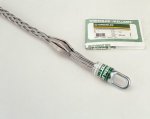Ansel
Member
- Location
- New York, NY
I have never used pulling calculations for communications cable. I have to calculate the maximum pulling tension for 24 Cat5e cables in 2" conduit. The cable size in diameter 0.24" overall with jacket. The conduit fill ends up being 37.5%. Each cable has 8 24AWG conductor. When I calculated the maximum pulling tension with 80% use, I calculated it to be 496.43 lb/force. I have read from the manufacturer that it should not exceed 25lb/force. I used two of the online pulling calculators and saw that it exceeded the 25lb/force. Am I doing this completely wrong?


